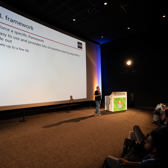Developing Web Apps with React
UREACT
3 days
Interested in a private company training? Request it here.
Not ready to book yet? Request an offer here.
Introducing React
Modern web applications put a lot of focus on the client. But how did we get here? This module explores the history of web development, explains the need for libraries like React, and shows you what exactly React is and what you can do with it.
- The Evolution of Web Development
- Components Everywhere
- Combining React with other Libraries
- React Tooling
Strongly Typed JavaScript with TypeScript
Let's face it: JavaScript was never designed for big applications. Many constructs to tame complex code like interfaces and strong typing are completely absent. TypeScript brings these features to the developer; allowing you to write modern, application-scale JavaScript.
- Writing Application-Scale JavaScript
- Type-Safe JavaScript Development with TypeScript
- Typescript configuration
- Types, Functions, Interfaces and Classes
- Modules
- LAB - Writing Business Logic with TypeScript
React Fundamentals
In this module, we take a look at how a React app is structured, the different ways to create components, and, most importantly, JSX. This syntax extension for JavaScript makes building React components a breeze.
- React App Structure
- Class-based and Functional Components
- JSX Crash Course
- Databinding, Collections and Interactivity
- Working with Child components
- Styling React Components
- LAB: React Fundamentals
State and Props
To be able to reuse and split our application into logical parts, we need components. These components are what we'll use to create interactivity in the application. Interactivity however, can only work if we keep track of the state of the application. This chapter explores the data flow of a React application and how React components communicate with each other.
- State in React Components
- Props and Data Flow
- Stateful and Stateless Components
- Transferring Props
- LAB: State and Props
Hooks
With the Hooks API, we can now add state and other concepts to Functional components. In this module, you'll learn the ins and outs of functional components and the hooks that make them great.
- Functional Components
- State Hook
- Effect Hook
- Things to Know when Using Hooks
- Building your own Custom Hooks
- LAB: React Hooks
Working with Forms
Forms are essential to any app that allows you to manage data. You need to do more than just data binding. You need validation, automatic formatting, response to data changes and so on. React gives you all the tools you need to do this, but there are also some interesting libraries around that can save you a lot of work.
- What's in a Form?
- Value Binding to State
- Controlled vs Uncontrolled Components
- Sanitizing and Validating Input
- Using Libraries to Manage your Forms
- LAB: React Hook Forms
Talking to the Server
Single Page applications are great! But where do they get their data? In this module, we'll explore how you can access a Back-end from React, and how to implement handy features like caching and lazy loading
- Fetch API
- When and Where to Fetch Data?
- Using the Effect Hook
- Using Libraries to Fetch your Data
- LAB: Talking To the Server
Component Composition
As your application becomes more complex, the need for organization and architecture grows. In this module, we'll see some nifty ways to share and reuse state and logic between different components
- props.children
- Working with Context and the UseContext Hook
- Rendering Dynamic Content with Render Props
Routing
Instead of hopping from one page to the next, you can design your website as a Single Page Application. This makes your website feel and perform more like an application. SPAs have many advantages but are usually difficult to implement. In this module, we take a look at React Router, the library of choice for client-side routing in React, and the features in React Router that make data loading during navigation simple and intuitive.
- Introducing React Router and its Modes
- Navigation
- Path and Parameters
- Data APIs in React Router
- Lazy Loading
- Component Lifecycle
- LAB: Building a Single Page Application with React-Router
Performance
Internally, React uses several clever techniques to minimize the amount of work required to update the UI. For many applications, using React will lead to a fast user interface without doing much work to specifically optimize for performance. Nevertheless, there are several ways you can speed up your React application when needed.
- Virtual DOM
- Using Memoization and the Callback Hook
- Avoiding Computational Work
- Avoiding Re-rendering
- Pitfalls
State Management
As Single Page Applications gain more and more features, they need to handle more and more state. Using a state management pattern can help us keep things neat and tidy.
- Externalizing State from Components
- Redux: the State Management Pattern of Champions
- Mobx: a Simpler, more Lightweight Alternative to Redux
Redux
This chapter will explore Redux. A data flow pattern for enterprise applications.
- What is Redux?
- Actors: Store, Actions, Reducers
- View and Hooks
- Asynchronous Actions
- Tools
- LAB: State Management with Redux
Testing with Jest
Because people need to create unit tests when writing code, the React team has created a library that makes it easier. Jest is a unit testing framework based on Jasmine. It allows for a couple of features that are very welcome in the JavaScript unit testing world.
- What is Jest?
- Creating Tests with Jest
- Asynchronous Methods
- Mocking
- Testing React components using Snapshots
- End to End testing with React Testing Library
Single Page Applications have become the norm for highly interactive Web Apps. React is at the forefront of this evolution, implementing a one-way reactive data flow, which is very intuitive and avoids lots of boilerplate code. By bringing TypeScript into the mix, we ensure the applications we build contain fewer bugs, are more scalable, and are easier to maintain. In this 3-day training developers will learn how to use React and its component based development to create rich and dynamic web applications.
This course targets professional web developers who are familiar with modern JavaScript (ES2015+) and HTML and are looking for ways to improve their productivity with React. The main focus is getting started in the React world with the help of a step by step introduction to the framework.











